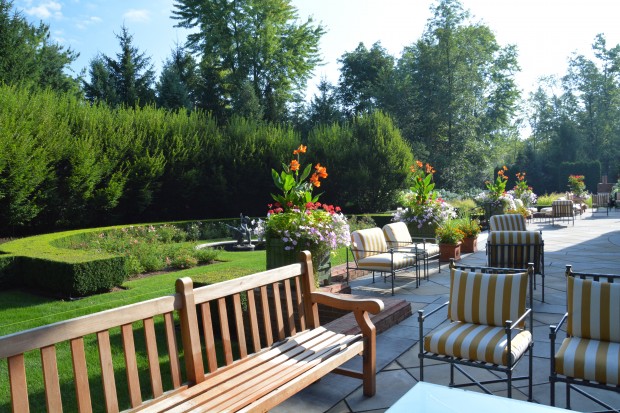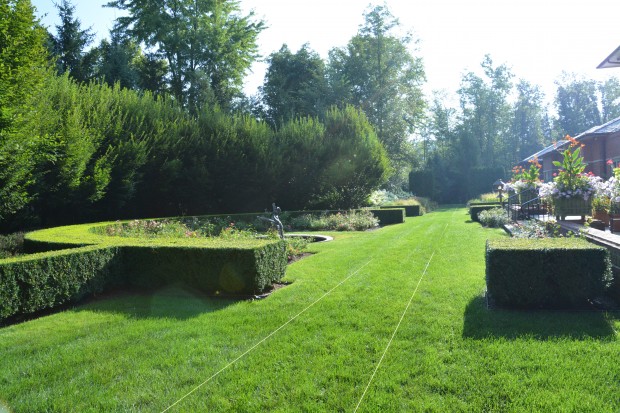 This terrace sits a number of steps above the surrounding landscape and garden. I would guess the terrace sits almost 3 feet above the ground plane. There are plenty of places to sit. Lots of chairs with plump cushions make this experience of the outdoors comfortable. I would choose being outdoors above any other place to be, like most gardeners. Anyone who sits here has a great overview of all that is going on here. A landscape structured around a sweep of old hornbeams, blocks of hydrangeas and boxwood framing, is softened by generously sized perennial plantings. All of the pots and boxes help to bring the garden upstairs, and up closer.
This terrace sits a number of steps above the surrounding landscape and garden. I would guess the terrace sits almost 3 feet above the ground plane. There are plenty of places to sit. Lots of chairs with plump cushions make this experience of the outdoors comfortable. I would choose being outdoors above any other place to be, like most gardeners. Anyone who sits here has a great overview of all that is going on here. A landscape structured around a sweep of old hornbeams, blocks of hydrangeas and boxwood framing, is softened by generously sized perennial plantings. All of the pots and boxes help to bring the garden upstairs, and up closer.
 Landscapes that are viewed from afar, or from up above, have their charms. The stray weed, or problem plant will not read all that well. The overall impression is stronger and more lasting than any individual detail. My deck is five feet above the ground plane – I can take in the whole garden at a glance. From a design perspective, the organizing idea may be much clearer from a distance. A bird’s eye view of a garden looks much more like the landscape plan drawn on paper. For the same reasons, spotting problems with a design is easier, if that design can be seen all at once-in plan view. The ground floor view of a landscape in three dimensions can be very different than a 2 dimensional drawing that describes it.
Landscapes that are viewed from afar, or from up above, have their charms. The stray weed, or problem plant will not read all that well. The overall impression is stronger and more lasting than any individual detail. My deck is five feet above the ground plane – I can take in the whole garden at a glance. From a design perspective, the organizing idea may be much clearer from a distance. A bird’s eye view of a garden looks much more like the landscape plan drawn on paper. For the same reasons, spotting problems with a design is easier, if that design can be seen all at once-in plan view. The ground floor view of a landscape in three dimensions can be very different than a 2 dimensional drawing that describes it.
 Immersion in a garden can be great. All of the subtle details, the contrasts of textures, the relationships of one plant to another, and the flowers can be better appreciated up close. I have spent lots of time over the years wading in to people’s gardens-to pull weeds, or dig plants that needed dividing. Up close can also mean that bugs, disease and snakes become part of the experience. It is tougher to spot the ground hog burrows and ground bees nests. The whole point of layering a perennial garden is so that depth of the space can be appreciated from the perimeter. Gardens planted from a variety of plants close in height have a beautiful undulating rhythm, provided those plants mature at a height below eye level. Gardens planted with with plants taller than eye level need a way in, or a place to step back.
Immersion in a garden can be great. All of the subtle details, the contrasts of textures, the relationships of one plant to another, and the flowers can be better appreciated up close. I have spent lots of time over the years wading in to people’s gardens-to pull weeds, or dig plants that needed dividing. Up close can also mean that bugs, disease and snakes become part of the experience. It is tougher to spot the ground hog burrows and ground bees nests. The whole point of layering a perennial garden is so that depth of the space can be appreciated from the perimeter. Gardens planted from a variety of plants close in height have a beautiful undulating rhythm, provided those plants mature at a height below eye level. Gardens planted with with plants taller than eye level need a way in, or a place to step back.
 A tall shallow garden without a place to step back is like having a seat at a movie that is too close to the screen. That movie experience makes it impossible to focus, and make sense of any visual information. Up close to a field of sunflowers is the same visual experience as up close to a row of them. There is no sense of the depth of the garden, unless there is an alternate way to view them. These gardens have plenty of space to step back, and take it all in. The plantings are graduated in height. For some, a grass walkway is all it takes to bring the garden up close. For others, a walkway is a better solution. A garden walkway makes it possible to enjoy a garden after a rain without risking soaking wet shoes. Its easier to push a wheelbarrow or cart on a hard surface. For those that like to walk the garden in the evening, a path can help light the way.
A tall shallow garden without a place to step back is like having a seat at a movie that is too close to the screen. That movie experience makes it impossible to focus, and make sense of any visual information. Up close to a field of sunflowers is the same visual experience as up close to a row of them. There is no sense of the depth of the garden, unless there is an alternate way to view them. These gardens have plenty of space to step back, and take it all in. The plantings are graduated in height. For some, a grass walkway is all it takes to bring the garden up close. For others, a walkway is a better solution. A garden walkway makes it possible to enjoy a garden after a rain without risking soaking wet shoes. Its easier to push a wheelbarrow or cart on a hard surface. For those that like to walk the garden in the evening, a path can help light the way.
 This all around the garden walkway is a long one. A gravel path was an obvious choice. A stone walkway of this width and length would be overpowering visually, especially given that it is set close and parallel to a large stone terrace. A decomposed granite path is simple to install. We dug out 6″ of soil, and installed in its place 4″ of crushed limestone, and a 2″ top dressing of decomposed granite. This was a very long and fairly wide walk. We have 2 clients who like to cruise the garden, together. Four feet wide is a comfortable width for 2 people who are friendly with one another to walk side by side. So 40 yards of soil went to the compost pile at our landscape yard.
This all around the garden walkway is a long one. A gravel path was an obvious choice. A stone walkway of this width and length would be overpowering visually, especially given that it is set close and parallel to a large stone terrace. A decomposed granite path is simple to install. We dug out 6″ of soil, and installed in its place 4″ of crushed limestone, and a 2″ top dressing of decomposed granite. This was a very long and fairly wide walk. We have 2 clients who like to cruise the garden, together. Four feet wide is a comfortable width for 2 people who are friendly with one another to walk side by side. So 40 yards of soil went to the compost pile at our landscape yard.
 This property is notorious for retaining water. Before the landscape construction began, we did install a fairly extensive drainage system. Forty yards of gravel in place of forty yards of soil can’t hurt the drainage effort. Decomposed granite is composed of granite chips, 3/8 of a inch and smaller in size. The very small pieces are known as fines, and have the appearance of sand. Once the gravel has been compacted, rain will wash the fines down, and help to interlock the larger pieces. This water permeable walk is quote hard, once it has a little age. It would be easy to ride a bike here. It is a lot of work to haul stone and soil, but there is little in the way of materials.
This property is notorious for retaining water. Before the landscape construction began, we did install a fairly extensive drainage system. Forty yards of gravel in place of forty yards of soil can’t hurt the drainage effort. Decomposed granite is composed of granite chips, 3/8 of a inch and smaller in size. The very small pieces are known as fines, and have the appearance of sand. Once the gravel has been compacted, rain will wash the fines down, and help to interlock the larger pieces. This water permeable walk is quote hard, once it has a little age. It would be easy to ride a bike here. It is a lot of work to haul stone and soil, but there is little in the way of materials.
 The most expensive material is the edger strip. These 16 feet long by 4″ high aluminum strips keep the gravel where it is intended. It also keeps the grass out of the walk. Just before the stone goes in, we use a layer of non-woven landscape fabric that is permeable to water, but discouraging to weeds. If a decomposed granite walk goes through a garden, there is little need for edging. We may mulch the perimeter plantings with the same stone. Perennials that seed in the walk may be welcome.
The most expensive material is the edger strip. These 16 feet long by 4″ high aluminum strips keep the gravel where it is intended. It also keeps the grass out of the walk. Just before the stone goes in, we use a layer of non-woven landscape fabric that is permeable to water, but discouraging to weeds. If a decomposed granite walk goes through a garden, there is little need for edging. We may mulch the perimeter plantings with the same stone. Perennials that seed in the walk may be welcome.
 Once the granite is in place, we go over and over it with a compactor so the surface is firm, and level. Given the inch and a half of rain we had this afternoon, this path looks a lot more like gravel, and a lot less like sand. Gravel is a friendly material to use when there are irrigation valve boxes and heads set close to the surface. We just go around them. Given a little dry weather, my clients will be able to go around too.
Once the granite is in place, we go over and over it with a compactor so the surface is firm, and level. Given the inch and a half of rain we had this afternoon, this path looks a lot more like gravel, and a lot less like sand. Gravel is a friendly material to use when there are irrigation valve boxes and heads set close to the surface. We just go around them. Given a little dry weather, my clients will be able to go around too.